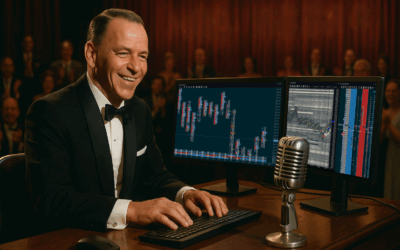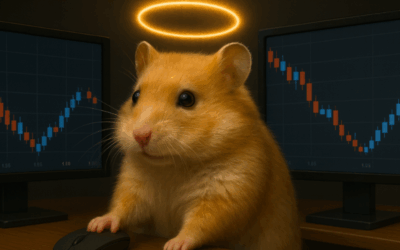Trading Rule #2 – Knowledge alone is NOT power in trading
A lot of people might be thinking – “Rule 2 and no setup?” Or maybe, “Why not just do a single eBook with 100 rules in it?”.
Well, remember that day at school where they taught you how you learn? Nope – nor me. To learn to trade, you need to understand the facets of learning. It’s not a lot of information, but I request just a little patience, and you will be rewarded.
As for “why not in 1 eBook” It’s simple. You would forget it all. It would not embed. “Hey – he talked about embedding already – why do it again?”.
I am talking about embedding again to embed the concept of embedding.
Learning anything is a journey from A to B. My responsibility as the author is to get information into your head and stay there, so you can take that journey:
- There will be subtle repetition, aka reinforcement.
- There will be quirky/memorable stories – off the wall stuff that is easier to remember than boring vanilla statements – like the one above.
- There will be quirky analogies – off the wall ones, intended to jolt and be memorable
But mostly, we will feed you information 2-3 times a week, allowing each building block to sink in.
We will not use big words or complex terminology. So your focus will be 100% on what’s being said and 0% processing rarely used words that we all understand but don’t use much.
Stories are an amazing tool. In fact, just today, I was waiting in the pub for my daughter to finish her music classes. A waitress came up and asked if I was OK as I was sitting there just blankly staring into space. I said “I was just thinking” and she replied – you must be clever. Now, to me – that’s a pretty low bar to set for being clever. So “you’re a thinker”.
This is a good example of a memorable story. It’s a tool to help people hold onto knowledge you teach them.
There’s 4 building blocks of trading mastery.
1 – Knowledge/Factual Recall
Theoretical foundation from books, courses, webinars, podcasts. The “what” behind concepts like chart patterns, risk formulas, order flow or market psychology. We will stick to vetted knowledge, but you are ultimately the gatekeeper of which knowledge you believe – a process we’ll discuss later (but one we just started to embed). You are free to use other knowledge that isn’t in this series.
Some knowledge is nonsense, and some simply doesn’t apply. If you read fund quarterly reports or watch Bloomberg TV – you’ll see 200/50 moving averages mentioned a lot. But it’s mostly irrelevant to a day trader.
Knowledge alone will not turn you into a profitable trader
I once attended a course in software project estimation. We looked at 7 techniques. It was 25 years ago – I still remember the dumbest one and the one I decided to take back to the company
Typically, the programming courses I taught were 1 week. Any longer and we’d split into 2. Retention from such trainings is typically:
- For conscious recall of facts, about 50% is forgotten in the first hour.
- 70% within 24 hours.
- Up to 90% in a week; passive formats like lectures retain 5-10%, and business training see 80% forgotten within 30 days.
These stats aren’t as discouraging as they appear, they highlight that the key to long-term retention is immediate hands-on application and repetition, which leads us to skills. It’s more the overall “gist” of a thing you need to learn, then you go to turning it into a skill.
2 – Skills Development/Subconscious Retention
If you learnt to play guitar, you wouldn’t read a chord book for 2 weeks and then start playing ‘cause your fingers wouldn’t be able to switch chords fast enough. By the time you got to the end of the book, there is zero chance you’d remember the chords from the start of the book.
Information from books and courses fades fast if you don’t use it. Skill development aka “hands on application/practice” are what turn that info into something you do without thinking, like driving.
You also retain more than you think. There’s context-dependent memory, where you might blank on a fact in a test but it clicks right away when a real problem needs it.
So you don’t get hit with all the knowledge at once. It’s broken up into a cycle of knowledge and practice.
3 – Wisdom
In a way, this is the process of having your ass handed to you repeatedly till you stop doing dumb stuff (excuse the language – I’m embedding).
Wisdom is the art of knowing when to act, hold, or fold, applying knowledge with timing, restraint, and insight. It’s not something you pick up from a weekend seminar; it’s forged in the fire of screw-ups. It’s not something you intentionally build – but that comes with experience and stepping back when NOT in the heat of the moment and analysing your trades critically.
We build wisdom bit by bit through real-life trials, mulling over the misses, because without it, all the facts and skills in the world just sit there unused, like tools rusting in a shed. It’ll sneak up on you as we roll through these rules, sharpening that inner voice that says “go” or “whoa” at just the right moment.
It’s like the young bull and the old bull at the top of a hill (don’t google that).
4 – Talent
That’s your spark, your innate capabilities. What you bring to the table. Some talents are negative to trading and some are positive. You can tweak your trading approach to take advantage of your talents.
Many pilots are terrible traders. They want a “dashboard” or “cockpit” of information that tells them how the market is flying. You try to tell them “it’s best to just look at a couple of things” – but their talent holds them back.
I have ADHD with a very big H. I can’t remember facts well but I can remember relationships between them.
Fact A <———- Relationship Z ———-> Fact B
Hyperactives can be better at seeing the big-picture connections (those “Relationship Z” bridges) while the isolated facts (A or B alone) slip away without context. I easily remember Z – and it just happens to have an A and a B at each end. This is how I remember A and B. Our product is over a million lines of code – but it’s all related to each other. So when the guys have an issue and they ask for advice – they usually start with explaining how that part of the code works – and I often just stop them and tell them how to fix it. When they tell me the issue, the fix pops up in my head and I can tell them everywhere in the product to make changes without looking at the code.
BUT
I can’t remember anyone’s birthday. I never remember anyone’s name when I meet them. I come across bit “Forrest Gump” to people.
I have to lean into that in trading. If you could trade birthdays – that would not be for me. Order flow helped my need for constant input and even if you give me a 100% working setup – I could not use it unless I knew the relationships that were causing it to work.
Conclusion
You don’t have to believe everything I write, but I believe:
- As much as people think trading is about being told a secret setup. That’s impatience and naivety.
- It’s more like climbing stairs – you climb each step of knowledge and turn it into a skill before the next step.
- Wisdom comes as you get burnt and learn the nuances. Your nuances and the markets.
- Natural or learnt non-trading talents may help or hinder.
- Watching someone trade rarely has benefit because it’s knowledge only.
This might make the journey sound arduous – yet it isn’t any more work than any other way.
You have to do NOTHING with this information now. Just let it sink in and either accept it or reject it. But don’t kid yourself that you can just look at a market, make a guess and trade – because that’s for impatient losers.
We are going to help you hone in and find what’s best for you as this is the shortest path. That will obviously include where to focus.
FREE BONUS: Take a look into the decision-making process of professional traders with this video training series that helps you make smarter trading decisions.




Enjoy thank you Peter